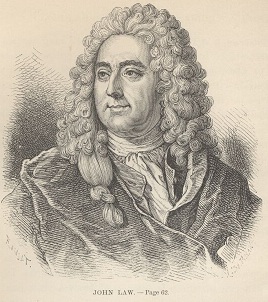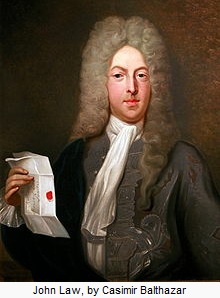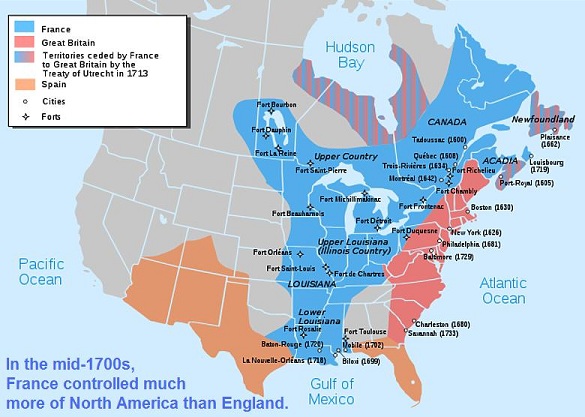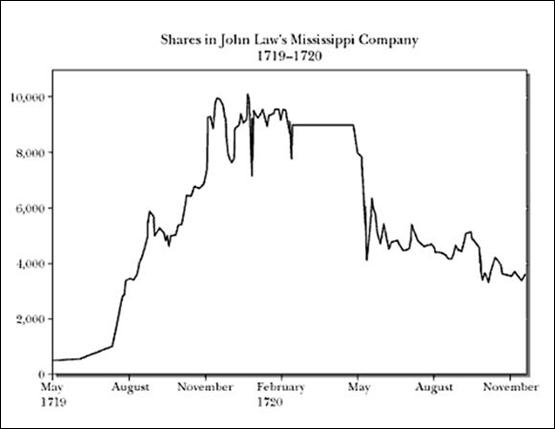By Jesse Colombo (This article was written on July 7th, 2012)
In 1720, at the same time as Britain’s South Sea Bubble, France experienced a similar bubble and financial crisis – the Mississippi Bubble.
 The seeds of the bubble were sown 1715, when France was nearly insolvent from war. The country had defaulted on its debt and cut back on interest payments. High taxes quickly burdened the French economy and the value of its gold and silver currency fluctuated wildly. At this time, France’s King Louis the XV was only five-years old, so the Duke of Orleans was the French government’s acting ruler and chief. As France’s dire fiscal and economic crisis wore on, the Duke of Orleans sought the help of his friend John Law, a Scottish financier and economic theorist.
The seeds of the bubble were sown 1715, when France was nearly insolvent from war. The country had defaulted on its debt and cut back on interest payments. High taxes quickly burdened the French economy and the value of its gold and silver currency fluctuated wildly. At this time, France’s King Louis the XV was only five-years old, so the Duke of Orleans was the French government’s acting ruler and chief. As France’s dire fiscal and economic crisis wore on, the Duke of Orleans sought the help of his friend John Law, a Scottish financier and economic theorist.
John Law was born in Edinburgh, Scotland in 1671 to a goldsmith who lent money on the side. Law became his father’s apprentice and became well versed in the principles of banking. Law soon moved to England, where he became involved in a duel in which he killed his opponent and was convicted of murder. Law eventually managed to escape prison and quickly left England to travel Europe. Due to his keen mathematical abilities, Law earned much of his wages from gambling. John frequented destinations such as Amsterdam, Venice and Genoa. It was in these financial centers that John Law renewed his fascination with high finance. In 1705, Law published a monetary economics theory in which he argued against the use of metallic money in favor of paper money due to his belief that its use would stimulate commerce (Smant).
After the desperate Duke of Orleans sought for John Law’s help, Law quickly devised a strategy to stabilize the French economy. In May 1716, Law established the Banque Generale, designed after the successful Wisselbank of Amsterdam (Smant). Banque General took deposits of gold and silver and issued paper money in return. These banknotes were redeemable in the metallic currency at the time that banknotes were issued. Banque Generale built equity through the selling of shares as well as through the management of the French government’s finances. To John Law’s credit, the French economy had soon stabilized, which helped to increase his rapport and influence within the French government.
 Pursuing a new venture in August 1717, John Law acquired the ailing Mississippi Company and merged it with Banque Generale. France had granted the Mississippi Company a trading monopoly with the French colonies, commonly called “French Louisiana.” The trading monopoly carried a high-perceived value as speculation arose over the prospects of the beaver skin trade and the discovery and production of precious metals, with Indian slaves to mine them. France was looking to profit enormously, as Spain did with Mexico and Peru.
Pursuing a new venture in August 1717, John Law acquired the ailing Mississippi Company and merged it with Banque Generale. France had granted the Mississippi Company a trading monopoly with the French colonies, commonly called “French Louisiana.” The trading monopoly carried a high-perceived value as speculation arose over the prospects of the beaver skin trade and the discovery and production of precious metals, with Indian slaves to mine them. France was looking to profit enormously, as Spain did with Mexico and Peru.
The Mississippi Company raised capital by selling shares to investors looking to take part in the “spoils of the Indies.” Shares were bought and paid for with bank notes or with government debt. The Mississippi Company increased its authority when it “Expanded to monopolize all French trade outside Europe. In July 1719 the Compagnie purchased the right to mint new coinage. In August 1719 the Compagnie bought the right to collect all French indirect taxes and in October 1719 the Compagnie took over the collection of direct taxes. Finally, a plan was launched to restructure most of the national debt, whereby the remainder of existing government debt would be exchanged for Compagnie shares.” (Smant)
Mississippi Company shares were offered to public in January 1719 at 500 livres per share (the French currency of the time). The French public developed an insatiable desire for the company’s shares, causing prices to reach 10,000 livres per share by December 1719, a gain of 1,900 percent. People of all social classes became investors and many became millionaires just from their holdings of Company shares. Interestingly, the French word “millionaire” originated to describe the speculators who became wealthy as a result of the Mississippi Bubble. (Moen)
The Mississippi Company gained 80,500,000 livres in revenue from interest paid by the King on loans and by profits from tobacco, the mint and trading (Smant), further bolstering investors’ confidence.
Profit taking started in January 1720, with investors receiving payment in the form of gold coins. In order to discourage more aggressive selling, John Law limited payments in gold of more than 100 livres (Moen).
The amount of bank notes in circulation had increased 186% in one year due to the rampant issuance of notes to fund share purchases. As a result, a powerful inflationary episode ensued in which the price of goods doubled between July 1719 and December 1720. Much of the Mississippi Company’s share price gains were due to inflation as well, rather than from pure investor demand (Smant). As more Banque Generale notes were issued without a corresponding increase in the bank’s precious metals holdings, the majority of notes were no longer backed by precious metals, essentially rendering them worthless.
A scandal struck in May 1720 when John Law decided that Company stock prices were overvalued, causing him to devalue its shares. John Law also devalued Banque Generale notes by 50%. Intense protest resulted in a compromise in which the bank notes’ value was restored but payment in precious metals was stopped. The public was outraged against the Company and the Banque’s near-worthless paper money.
Under intense selling pressure and Law’s devaluation, shares had collapsed from 10,000 livres per share to 1,000 by December 1720. At the end of 1720, John Law’s enemies confiscated two-thirds of shares, giving them control of the company. Share prices further deflated to 500 livres by 1721 (Moen). Investors were financially devastated and many former millionaires lost their entire fortunes.
The collapse of the Mississippi Company plunged France and neighboring European countries into an economic depression, which layed the groundwork for the French Revolution that occurred later in the century. John Law was viewed as a scam-artist and was exiled from France. Law returned to his gambling roots in mainland Europe and died in poverty.
Although traditionally called a bubble, the Mississippi Bubble wasn’t actually a bubble in technical sense. A bubble is caused by widespread mania and speculation, followed by a brutal collapse in asset values. In contrast, the Mississippi Bubble was a failure of monetary policy that resulted in excessive money supply growth and inflation.
Other Mississippi Bubble Resources:
The Mississippi Bubble of 1718-1720
Famous First Bubbles: Mississippi Bubble
John Law and the Mississippi Bubble 1718-1720
Encyclopedia Britannica: Mississippi Bubble



